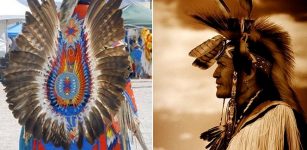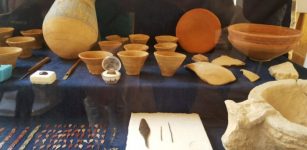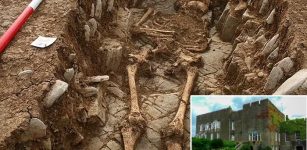Sunduki – ‘Home Of The Gods’ – One Of The World’s Oldest Astronomical Observatories
A. Sutherland - AncientPages.com - Many people believe that one of the oldest astronomical observatories is Stonehenge. However, an ancient and spectacular Sunduki (or "home of the gods") could today be considered the world's oldest astronomical observatory.
It was not only a place of huge religious significance in the ancient world of our ancestors but also its stargazing capital.
Sunduki is referred to as the Siberian Stonehenge and is believed to be at least 16,000 years old, thus it's much older than Stonehenge.

Starscape: Sunduki is a series of eight box-shaped sandstone outcrops on a remote flood plain on the bank of the Bely Iyus river in remote Siberia.
The mountain ridge Sunduki (the Boxes) was long studied by Professor Vitaly Larichev, of the Institute of Archaeology and Ethnography at the Siberian Branch of the Russian Academy of Sciences. According to Larichev, Sunduki is the oldest astronomical observatory certainly in Asia. Its age is about 16,000 years old. The ancient inhabitants of this valley daily observed the sunset, the sunrise, and the moon.
His studies showed that the ancient Siberians were able to use a combination of giant rocks and chinks in the stony landscape to make their astronomical observations, including identifying a point where the sun rises on the summer solstice.
According to Professor Vitaly Larichev, the ancient Siberian astronomers could also tell time and direction easily. Referring to a certain petroglyph depicting a dragon pointing in one direction, and snake in the other, he explained:
“If the sun were shining, we could tell the time. In the morning the shadow moves along the snake’s body from his head to his tail, and in the afternoon it comes from the other direction along with the dragon. From the same observation point, you can determine true north and south by sighting along the mountains.”

High on one cliff wall is a rock engraving showing dragon heads in one direction, and snakeheads in the other.
The rich region of the region of Sunduki delivered many fascinating finds like burial mounds (kurgans), rock drawings, and stone monuments.
The word 'Sunduk' in Russian means 'chest' or 'trunk' which explains how the place got its modern name.
"For many years I tried to unravel these mystery 'chests'," said Professor Vitaly Larichev said. Determined to decode some of the mysteries of Sunduki, he admits he became an 'astro-archeologist'.
"We don't dig in the ground - we study what ancient people knew about astronomy', he said.
What I discovered was a surprise even to myself. Comparing maps accumulated over many years of astronomical observations, I came to understand that here in Sunduki, we can see the oldest astronomical observatory certainly in Asia. Its age is about 16,000 years old. The ancient inhabitants of this valley daily observed the sunset, the sunrise and the moon'. They did so for many thousands of years since then, which means it's millennia-old tradition. Based on what is known so far, the first sundials existed about 3,500 years ago in Egypt. Ancient Siberian astronomers did not have such instruments.
Instead, they used giant rocks and chinks in the stone architecture in this Siberian landscape for their calculations and observations.
Professor Larichev informed that he found 'numerous ancient solar and lunar observatories around Sunduki.
"This square pattern of stones on the ground shows you the place. I knew there would be an orientation point, but we had to search through the grass for a long time to find it. Now, look up to the top of that ridge. You see a place where there is a crack between the rocks? If you were here on the summer solstice, you would see the sunrise right there. Or you would if you were here 2,000 years so. Now the timing is slightly different," Professor Larichev explained.
High on one cliff wall is a rock engraving showing dragon heads in one direction, and snakeheads in the other.
"If the sun were shining, we could tell the time,' Professor Larichev said. "In the morning the shadow moves along the snake's body from his head to his tail, and in the afternoon it comes from the other direction along the dragon. From the same observation point you can determine true north and south by sighting along the mountains."There is a gallery of rock art. Some dates back several centuries BC and so is relatively modern.
But a mysterious white horse found not far from the first 'chest' on Black Mountain was carved in the rock and is well preserved - yet scientists suggest that this petroglyph appeared 16,000 years ago, during the Ice Age, establishing this as a site of human activity over many millennia.
"It was 'the home of gods, great artists, and skywatchers', said the professor. It was more than this, too."
There are also burial mounds and other manmade constructions - including irrigation channels - which have yet to be fully investigated. The great story of Sunduki is only partly known and many ancient secrets of Sunduki have not been revealed.
Written by – A. Sutherland - AncientPages.com Senior Staff Writer
Copyright © AncientPages.com All rights reserved. This material may not be published, broadcast, rewritten or redistributed in whole or part without the express written permission of AncientPages.com
Expand for referencesReferences:
Kira Van Deusen, Singing Story, Healing Drum: Shamans and Storytellers of Turkic Siberia
More From Ancient Pages
-
 Extremely Brutal Conflicts Among Maya Broke Out Before Civilization’s Decline
Archaeology | Aug 8, 2019
Extremely Brutal Conflicts Among Maya Broke Out Before Civilization’s Decline
Archaeology | Aug 8, 2019 -
 Mysterious Valkyrie Eir Remains An Enigma In Norse Mythology
Featured Stories | Apr 4, 2018
Mysterious Valkyrie Eir Remains An Enigma In Norse Mythology
Featured Stories | Apr 4, 2018 -
 Dozens Of Giant ‘Lost’ Nazca Geoglyphs Unearthed By Drones In Peru
Archaeology | Apr 7, 2018
Dozens Of Giant ‘Lost’ Nazca Geoglyphs Unearthed By Drones In Peru
Archaeology | Apr 7, 2018 -
 Search For Noah’s Ark Continues – The ‘Inside Mount Ararat’ Research Project
Featured Stories | May 4, 2014
Search For Noah’s Ark Continues – The ‘Inside Mount Ararat’ Research Project
Featured Stories | May 4, 2014 -
 Mysterious Ancient Human Skeletons Found In Florida Lake Puzzle Archaeologists – Unknown Lost Settlement?
Featured Stories | May 21, 2024
Mysterious Ancient Human Skeletons Found In Florida Lake Puzzle Archaeologists – Unknown Lost Settlement?
Featured Stories | May 21, 2024 -
 What Was The Symbolism Behind Native American Feathers?
Ancient History Facts | Apr 21, 2017
What Was The Symbolism Behind Native American Feathers?
Ancient History Facts | Apr 21, 2017 -
 Unique Ancient Three-Headed Eagle Pendant Discovered In Finland: A Symbol Of Three Different Human Souls
Ancient Symbols | May 6, 2016
Unique Ancient Three-Headed Eagle Pendant Discovered In Finland: A Symbol Of Three Different Human Souls
Ancient Symbols | May 6, 2016 -
 Kingdoms Of Judah And Babylon Remained In Long-Lasting Conflict
Featured Stories | Sep 5, 2019
Kingdoms Of Judah And Babylon Remained In Long-Lasting Conflict
Featured Stories | Sep 5, 2019 -
 Ramanathaswamy Temple Has Spectacular Corridors With Over 4000 Pillars
Featured Stories | Jun 9, 2021
Ramanathaswamy Temple Has Spectacular Corridors With Over 4000 Pillars
Featured Stories | Jun 9, 2021 -
 Fragment Of A 1,750-Year-Old New Testament Translation Discovered
Archaeology | Apr 7, 2023
Fragment Of A 1,750-Year-Old New Testament Translation Discovered
Archaeology | Apr 7, 2023 -
 William The Conqueror: Ruthless And Powerful Ruler Who Changed Britain Forever
Featured Stories | Feb 25, 2023
William The Conqueror: Ruthless And Powerful Ruler Who Changed Britain Forever
Featured Stories | Feb 25, 2023 -
 New Discoveries In the Valley Of The Monkeys In Luxor, Egypt
Archaeology | Oct 11, 2019
New Discoveries In the Valley Of The Monkeys In Luxor, Egypt
Archaeology | Oct 11, 2019 -
 Bizarre Meat-Eating Dinosaur Found In Classic Fossil Site In Egypt’s Sahara Desert
Archaeology | Jun 9, 2022
Bizarre Meat-Eating Dinosaur Found In Classic Fossil Site In Egypt’s Sahara Desert
Archaeology | Jun 9, 2022 -
 Mysterious Medieval Cemetery In Wales With People Buried In Unusual Positions Puzzles Archaeologists
Archaeology | Jan 3, 2024
Mysterious Medieval Cemetery In Wales With People Buried In Unusual Positions Puzzles Archaeologists
Archaeology | Jan 3, 2024 -
 Viking Age silver coins unearthed in Jutland
Artifacts | Aug 27, 2015
Viking Age silver coins unearthed in Jutland
Artifacts | Aug 27, 2015 -
 Ukko: Karelian-Finnish God Of Thunderstorms, Harvest, Patron Of Crops And Cattle
Featured Stories | Apr 2, 2020
Ukko: Karelian-Finnish God Of Thunderstorms, Harvest, Patron Of Crops And Cattle
Featured Stories | Apr 2, 2020 -
 Roman ‘Backwater’ Challenges Major Assumptions About The Ancient Empire’s Decline
Archaeology | Dec 12, 2023
Roman ‘Backwater’ Challenges Major Assumptions About The Ancient Empire’s Decline
Archaeology | Dec 12, 2023 -
 Mystery Woman’s DNA Reveals Intriguing Relationship Between Neanderthals And Modern Humans In Europe
DNA | Dec 16, 2024
Mystery Woman’s DNA Reveals Intriguing Relationship Between Neanderthals And Modern Humans In Europe
DNA | Dec 16, 2024 -
 On This Day In History: Antarctic Explorer Lawrence “Titus” Oates Born – On Mar 17, 1880
News | Mar 17, 2017
On This Day In History: Antarctic Explorer Lawrence “Titus” Oates Born – On Mar 17, 1880
News | Mar 17, 2017 -
 Impressive Ancient Underground Tombs And Chapels Unearthed In Saqqara, Egypt
Archaeology | Apr 16, 2023
Impressive Ancient Underground Tombs And Chapels Unearthed In Saqqara, Egypt
Archaeology | Apr 16, 2023


